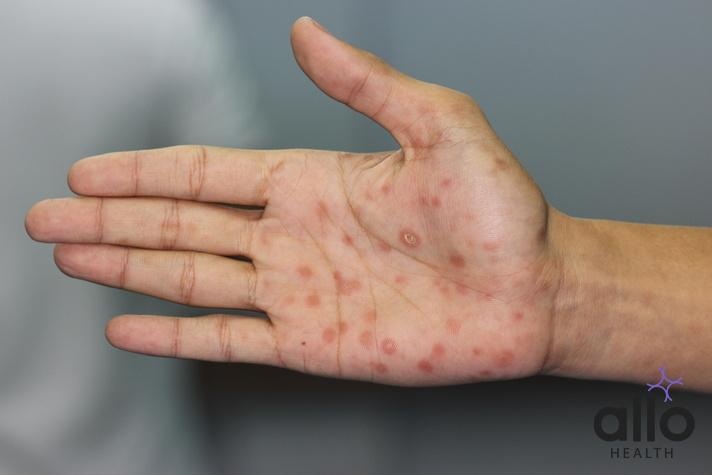Is Syphilis Bacterial, Viral, or Parasitic?

Allo Health is dedicated to personalized well-being, offering support and trusted information tailored to individual health goals. The platform emphasizes human-generated content, led by a distinguished medical team of experts, including physicians and sexual health specialists. Their commitment to credibility involves rigorous fact-checking, authoritative research, and continuous updates to ensure accurate, up-to-date information. Allo Health's unique approach goes beyond conventional platforms, providing expert-led insights and a continuous commitment to excellence, with user feedback playing a crucial role in shaping the platform's authoritative voice.

Dr. Aditi completed her undergraduate medical education at AJIMS, Mangalore, after which she worked in multi-speciality hospitals with COVID patients and in the Pain and Palliative medicine department. Driven by her experiences, she developed a keen interest in psychiatry. Dr. Aditi believes that mental health is just as, if not more important, than physical health.
Why This Was Upated?
Our experts continually monitor the health and wellness space, and we update our articles when new information became available.
Updated on 07 June, 2024
- Article was updated as part of our commitment to diversity, equity, and inclusion.

"The following blog article provides general information and insights on various topics. However, it is important to note that the information presented is not intended as professional advice in any specific field or area. The content of this blog is for general educational and informational purposes only.
Book consultation
The content should not be interpreted as endorsement, recommendation, or guarantee of any product, service, or information mentioned. Readers are solely responsible for the decisions and actions they take based on the information provided in this blog. It is essential to exercise individual judgment, critical thinking, and personal responsibility when applying or implementing any information or suggestions discussed in the blog."
Sexually transmitted infections (STIs) are a significant concern worldwide, affecting millions of people each year. One of the most well-known STIs is syphilis, a highly infectious disease caused by the bacteria Treponema pallidum. It primarily affects the genital area and can have severe complications if left untreated. But just what kind of pathogen is syphilis? Is it bacterial, viral, or parasitic? In this article, we will delve deeper into the characteristics of syphilis and answer this question conclusively.
Syphilis Overview
Syphilis is a sexually transmitted infection (STI) caused by the bacterium Treponema pallidum. It can also be transmitted from an infected mother to her unborn child during pregnancy. Syphilis has various stages, each characterized by different symptoms, and if left untreated, it can lead to serious complications.
Stages of Syphilis:
- Primary Syphilis:
- Symptoms: The first sign is typically a painless sore or ulcer called a chancre, which appears at the site of infection (genital, anal, or oral). This sore usually heals on its own within 3 to 6 weeks.
- Timeframe: 10-90 days after exposure.
- Secondary Syphilis:
- Symptoms: After the chancre heals, a rash often develops on the body, including the palms and soles. Other symptoms may include fever, swollen lymph nodes, sore throat, and patchy hair loss.
- Timeframe: Usually starts a few weeks to a few months after the appearance of the chancre.
- Latent Syphilis:
- Symptoms: No visible symptoms during this stage, but the bacteria remain in the body.
- Timeframe: Early latent syphilis occurs within the first year of infection, while late latent syphilis occurs more than a year after infection.
- Tertiary Syphilis:
- Symptoms: If the infection progresses, it can lead to severe damage to internal organs, including the heart, brain, nerves, and bones. This stage can be life-threatening.
- Timeframe: Can occur 10-30 years after the initial infection.
Diagnosis and Treatment:
- Diagnosis:
- Blood tests: Serologic tests, such as the Venereal Disease Research Laboratory (VDRL) or Rapid Plasma Reagin (RPR) tests, detect antibodies to the syphilis bacteria.
- Confirmation: Positive results are confirmed with specific tests like the Treponema pallidum particle agglutination assay (TP-PA) or fluorescent treponemal antibody absorption (FTA-ABS) test.
- Treatment:
- Primary and Secondary Syphilis: Penicillin is the preferred treatment. Other antibiotics may be used for those allergic to penicillin.
- Latent and Tertiary Syphilis: Treatment with penicillin is usually more prolonged.
Prevention:
- Safe Sex: Using condoms or dental dams can reduce the risk of transmission.
- Regular Testing: Regular STI screenings, especially for individuals with multiple sexual partners or engaging in high-risk behaviors.
- Partner Notification: If diagnosed with syphilis, informing sexual partners is crucial to prevent further spread.
Complications:
- Neurosyphilis: Infection of the nervous system.
- Cardiovascular Syphilis: Involvement of the cardiovascular system.
- Gummatous Syphilis: The formation of destructive, soft, tumor-like growths.
Note:
Syphilis can increase the risk of HIV transmission, and co-infection with both STIs is not uncommon. Early detection and treatment are essential to prevent complications and reduce the risk of transmission. It is crucial to consult with a healthcare professional for accurate diagnosis and appropriate treatment.

Is Syphilis Bacterial, Viral, or Parasitic?
Syphilis is a bacterial infection caused by the spirochete bacterium Treponema pallidum. The bacterium is a spiral-shaped, corkscrew-like organism belonging to the family Treponemataceae. Unlike viruses, which are intracellular parasites that require a host cell for replication, bacteria like Treponema pallidum are capable of independent existence.
Characteristics of Treponema pallidum:
- Bacterial Structure:
- Treponema pallidum is a thin, helically coiled bacterium with a distinctive spiral shape.
- The spiral structure helps it to move through tissues, including those of the human body, which contributes to its pathogenicity.
- Gram-Negative:
- Treponema pallidum is Gram-negative, meaning it does not retain the violet stain used in the Gram staining technique.
- This characteristic influences the structure of its cell wall and has implications for antibiotic susceptibility.
- Human Host Specific:
- Treponema pallidum is primarily a human pathogen and does not naturally infect animals. This specificity contributes to its transmission primarily through direct human-to-human contact.
Transmission of Syphilis:
- The primary mode of transmission is through sexual contact, including vaginal, anal, and oral sex.
- Mother-to-child transmission can occur during pregnancy or childbirth, leading to congenital syphilis.
Diagnosis and Testing:
- Laboratory tests, such as the Venereal Disease Research Laboratory (VDRL) and Rapid Plasma Reagin (RPR) tests, detect antibodies produced in response to the infection.
- Confirmation of syphilis is often done through specific tests like the Treponema pallidum particle agglutination assay (TP-PA) or fluorescent treponemal antibody absorption (FTA-ABS) test.
Treatment:
- Penicillin is the preferred antibiotic for treating syphilis. For individuals allergic to penicillin, alternative antibiotics may be used.
- Treatment is most effective in the early stages of infection.
Prevention:
- Safe sex practices, including the use of condoms or dental dams, can help prevent the transmission of syphilis.
- Regular STI screenings and partner notification are essential for prevention.
In summary, syphilis is caused by the bacterium Treponema pallidum, a Gram-negative spirochete. Understanding its bacterial nature is crucial for accurate diagnosis, appropriate treatment, and effective prevention strategies. If there is suspicion of syphilis infection, consulting a healthcare professional is important for proper testing and management.
Most Asked Questions
-
Is Syphilis Caused with the aid of a Bacterium, Virus, or Parasite?
Syphilis is because of a bacterium called Treponema pallidum. Unlike viruses or parasites, this spiral-formed bacterium is accountable for beginning the contamination. Understanding its bacterial nature is essential for correct analysis and effective treatment.
-
How is Treponema pallidum Different from Viruses or Parasites?
Treponema pallidum is a bacterium, no longer an epidemic or a parasite. Bacteria are single-celled organisms capable of impartial existence, whilst viruses and parasites commonly rely upon host cells for replication. The particular spiral shape of Treponema pallidum units it apart from other infectious marketers.
-
Why is Syphilis Classified as a Bacterial Infection?
Syphilis falls into the category of bacterial infections due to the fact it is because of the spirochete bacterium Treponema pallidum. Bacterial infections are regularly handled with antibiotics, and within the case of syphilis, penicillin is the preferred antibiotic for effective management.
-
Can Syphilis Be Considered a Parasitic Infection?
No, syphilis can not be taken into consideration a parasitic contamination. While parasites are organisms that live on or in a bunch organism, syphilis is as a result of a bacterium. The difference lies within the fact that parasites have a greater complicated lifestyles cycle and structure in comparison to micro organism.
-
How Does Syphilis Transmission Differ from Viral Infections?
Syphilis is mostly transmitted through sexual touch or from an inflamed mother to her unborn infant. This mode of transmission distinguishes syphilis from many viral infections, which can have diverse transmission routes, which include respiration droplets, blood, or sexual fluids. Understanding the specific transmission dynamics aids in preventive measures.






































